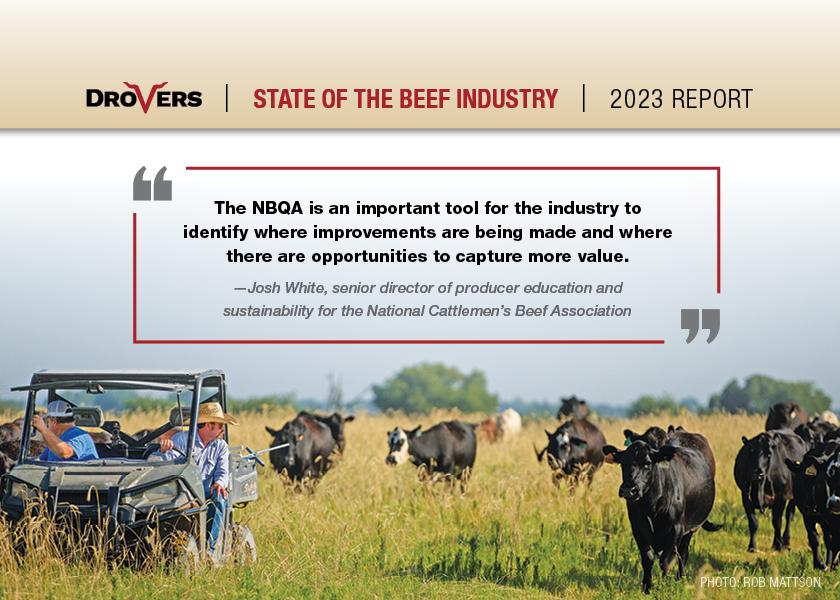What The 2022 National Beef Quality Audit Says About The Cattle Industry

Editor's Note: This article is the fourth in a series that comprise Drovers 2023 State of the Beef Industry. The full report will appear as a 16-page special section in the September 2023 issue. Additional articles from the series will be published in this space in the following days.
Three decades ago, the primary objective of America’s cattle and beef producers was to remain competitive with other proteins, especially the poultry industry. That desire spurred the landmark 1991 National Beef Quality Audit (NBQA), which produced some grim realities along with a road map for success.
The results of the first NBQA were too dramatic to ignore, former NCBA vice president of research and industry information Darrell Wilkes said at the time. He called the report the “proverbial 2'x4' between the eyes” telling the industry to implement changes. In short, carcasses were too fat, steaks too tough and blemishes too frequent.
Fast forward to the 2022 NBQA, which delivers many encouraging messages about beef’s improvement over the years while identifying issues that need further attention. The audit suggests the industry is producing a high-quality product that consumers want more efficiently and the industry’s primary focus across the supply chain remains food safety.
But as consumer demands have evolved, considerations outside of physical attributes have been added, such as sustainability, animal welfare and the connection between producers and consumers. By doing so, the results have been more beneficial to all parties involved.
Quality and Efficiency
“The NBQA is an important tool for the industry to identify where improvements are being made and where there are opportunities to capture more value,” says Josh White, senior director of producer education and sustainability for the National Cattlemen’s Beef Association. “The good news is, overall, the beef industry is providing a quality product to consumers that they enjoy.”
Quality, in fact, has reached levels higher than most thought possible. In the early 1990s, the percentage of carcasses grading Choice and Prime combined was slightly over 50%. In the 2022 audit, that combined percentage was 76% Choice and Prime combined. For several weeks over the past year, USDA market reports suggest that the percentage of Choice and Prime has exceeded 80%.
More than 25,000 carcasses were evaluated at packing and processing facilities to gather data for the NBQA. When comparing NBQAs from 2016 and 2022, the largest improvement was overall increased efficiency across the beef supply chain. And, it was noted, market segments no longer consider food safety as a purchasing criterion, but an expectation.
Some Key Findings Include:
- When comparing 2016 and 2022 NBQAs, the largest improvement was overall increased efficiency across the beef supply chain.
- Market sectors indicated their companies strive to increase their sustainability and work with the entire beef supply chain to do so.
- The entire industry felt the effects of the COVID-19 pandemic, nonetheless, beef proved to be a choice of consumers, and the industry persevered to provide products.
- Due to pandemic pressures, more cattle over 30 months of age were harvested.
- The beef industry’s image improved within fed cattle market sectors.
- Foreign materials continue to present a problem, but the industry is making strides to decrease incidence.
- There was an increase in usage of electronic identification (EID).
- There was an increase in the frequency of Prime and Choice quality grades, while Select decreased drastically.
- The industry is improving quality, but it is accompanied by an increase in carcass weight and fat thickness, as well as large increases in percentages of Yield Grade 4 and 5 carcasses.
- Nearly 93% of transportation service providers interviewed were familiar with the Beef Quality Assurance Transportation (BQAT) program and 91% are BQAT certified.
- Nearly 92% of cattle received a mobility score of 1, with the animal walking easily and normally. That’s a decrease from 97% in 2016 and is attributed to larger cattle and longer transport times.
Areas for Focused Improvement:
- While increasing numbers of producers are using technology for recordkeeping and data collection, others among the beef supply chain are concerned animal disease could impact the industry, and current traceability efforts do not provide a robust enough system to combat this potential threat.
- Carcasses were discounted for liver abscesses, causing product loss and decreased profitability.
- Preventative health strategies must be improved to ensure future effectiveness of antimicrobials.
- Heat stress and other environmental factors caused increased bruising, dark cutters and heart issues as well as decreased mobility.
- Increased bruising frequency should be addressed through facility and trailer design as well cattle handler training.
Eating Quality and Consistency:
- Numbers of Yield Grade 4 and 5 cattle increased, and improved genetics could maintain the ideal of Yield Grade 3 or better, while maintaining marbling necessary to achieve desired quality grades.
- Use advancements in genetic selection technologies to breed for carcasses with increased eating satisfaction, uniformity and desirable end-product specifications.







